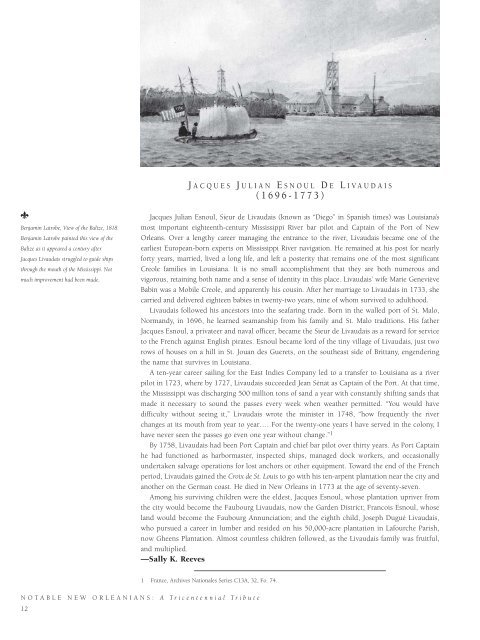Notable New Orleanians: A Tricentennial Tribute
An illustrated history of New Orleans paired with the histories of companies that have helped shape the city.
An illustrated history of New Orleans paired with the histories of companies that have helped shape the city.
Create successful ePaper yourself
Turn your PDF publications into a flip-book with our unique Google optimized e-Paper software.
J ACQUES J ULIAN E SNOUL D E L IVAUDAIS<br />
(1696-1773)<br />
<br />
Benjamin Latrobe, View of the Balize, 1818.<br />
Benjamin Latrobe painted this view of the<br />
Balize as it appeared a century after<br />
Jacques Livaudais struggled to guide ships<br />
through the mouth of the Mississippi. Not<br />
much improvement had been made.<br />
Jacques Julian Esnoul, Sieur de Livaudais (known as “Diego” in Spanish times) was Louisiana’s<br />
most important eighteenth-century Mississippi River bar pilot and Captain of the Port of <strong>New</strong><br />
Orleans. Over a lengthy career managing the entrance to the river, Livaudais became one of the<br />
earliest European-born experts on Mississippi River navigation. He remained at his post for nearly<br />
forty years, married, lived a long life, and left a posterity that remains one of the most significant<br />
Creole families in Louisiana. It is no small accomplishment that they are both numerous and<br />
vigorous, retaining both name and a sense of identity in this place. Livaudais’ wife Marie Geneviève<br />
Babin was a Mobile Creole, and apparently his cousin. After her marriage to Livaudais in 1733, she<br />
carried and delivered eighteen babies in twenty-two years, nine of whom survived to adulthood.<br />
Livaudais followed his ancestors into the seafaring trade. Born in the walled port of St. Malo,<br />
Normandy, in 1696, he learned seamanship from his family and St. Malo traditions. His father<br />
Jacques Esnoul, a privateer and naval officer, became the Sieur de Livaudais as a reward for service<br />
to the French against English pirates. Esnoul became lord of the tiny village of Livaudais, just two<br />
rows of houses on a hill in St. Jouan des Guerets, on the southeast side of Brittany, engendering<br />
the name that survives in Louisiana.<br />
A ten-year career sailing for the East Indies Company led to a transfer to Louisiana as a river<br />
pilot in 1723, where by 1727, Livaudais succeeded Jean Sénat as Captain of the Port. At that time,<br />
the Mississippi was discharging 500 million tons of sand a year with constantly shifting sands that<br />
made it necessary to sound the passes every week when weather permitted. “You would have<br />
difficulty without seeing it,” Livaudais wrote the minister in 1748, “how frequently the river<br />
changes at its mouth from year to year…. For the twenty-one years I have served in the colony, I<br />
have never seen the passes go even one year without change.” 1<br />
By 1758, Livaudais had been Port Captain and chief bar pilot over thirty years. As Port Captain<br />
he had functioned as harbormaster, inspected ships, managed dock workers, and occasionally<br />
undertaken salvage operations for lost anchors or other equipment. Toward the end of the French<br />
period, Livaudais gained the Croix de St. Louis to go with his ten-arpent plantation near the city and<br />
another on the German coast. He died in <strong>New</strong> Orleans in 1773 at the age of seventy-seven.<br />
Among his surviving children were the eldest, Jacques Esnoul, whose plantation upriver from<br />
the city would become the Faubourg Livaudais, now the Garden District; Francois Esnoul, whose<br />
land would become the Faubourg Annunciation; and the eighth child, Joseph Dugué Livaudais,<br />
who pursued a career in lumber and resided on his 50,000-acre plantation in Lafourche Parish,<br />
now Gheens Plantation. Almost countless children followed, as the Livaudais family was fruitful,<br />
and multiplied.<br />
—Sally K. Reeves<br />
1 France, Archives Nationales Series C13A, 32, Fo. 74.<br />
NOTABLE NEW ORLEANIANS: A <strong>Tricentennial</strong> <strong>Tribute</strong><br />
12
















